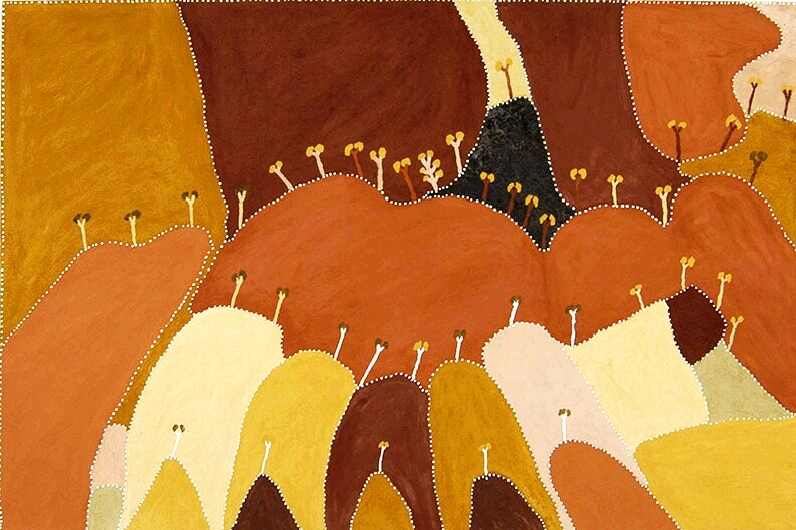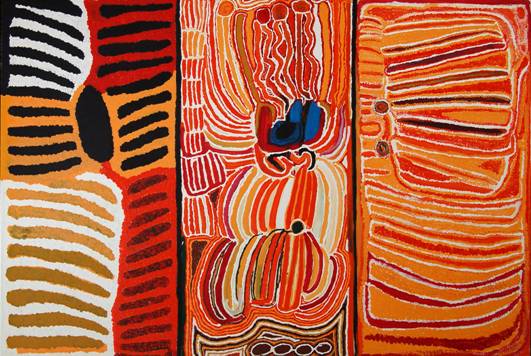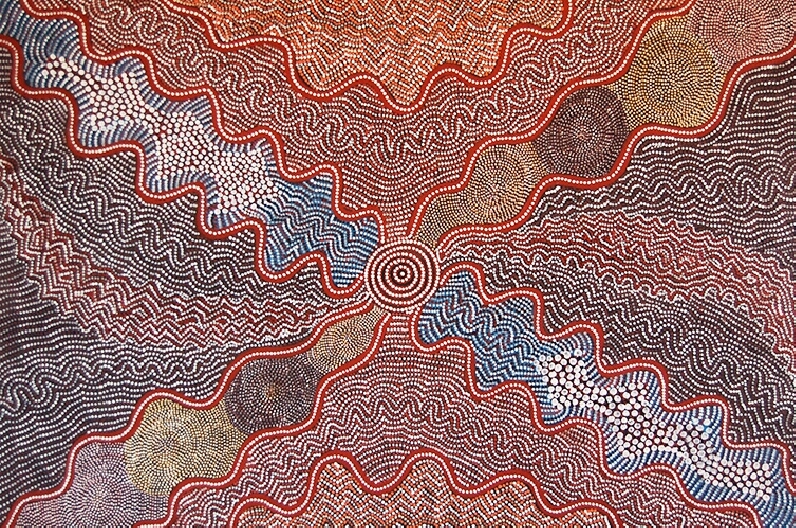Our sun-filled third floor gallery has been glowing with stunning artworks of both exceptional aesthetic merit as well as historical significance since October last year. By dedicating this expansive space solely to museum-quality pieces, our collection has grown significantly as we continue to acquire special works by those artists who have marked their place within the history of the Aboriginal art movement. Private collectors have come forward with paintings they have had hidden away in dark storerooms to contribute to this gallery, some having never been on public display. Community owned and run art centres have also provided us with their most ‘superstar’ paintings. Our collection continues to expand and evolve in exciting ways.
Representing a host of Australia's greatest master artists from across the central desert of Australia, this gallery functions as an opportunity to acquire the best of contemporary Aboriginal art in an inviting and informative environment. By virtue of both cultural and artistic importance, the works could take pride of place in both museums and public galleries anywhere in the world. Leading indigenous artists represented here include Clifford Possum, Emily Kame Kngwarreye, Turkey Tolson, Mick Namarari, Johnny Walangkura, Billy Stockman and many many more.
Three recent additions to our Collectors’ Gallery:

Patrick Mung Mung, NGARRGOOROON - WAPMM461/08, natural ochre pigment on canvas, 120 x 180cm, $16,550
The staff were thrilled to acquire this striking, yet subtle ochre work by Warmun’s Patrick Mung Mung. Soft and delicate tones in sand and teal are contrasted with rich and deep browns, marouns and charcoal. The dot work outlines the undulating landscape of the Warmun region and ads a shimmering effect on the eye. The naïve style trees give a skewed perspective on the land, adding further character to the bold design. This is a strong work by Patrick Mung Mung, clearly displaying all he is capable of as an artist.
Patrick Mung Mung is a senior artist, and respected elder of the Warmun Community in the East Kimberley. Painting since 1991, Patrick’s intricate knowledge of his country and cultural memory are powerfully linked in his work. Patrick’s work is strongly influenced both aesthetically and thematically by the previous generation of Warmun artists, which include the famous Rover Thomas and Paddy Jaminji.

Eubena Nampitjin, Lucy Yukenbarri, Muntja Nungura (collaboration) - KARYANKGU (rockhole), MALIKI, TJINJULLU (soakwater)
ELMX645/96, acrylic on linen, 120 x 180cm, $29,300
What a rare and special collaborative piece by three highly acclaimed Balgo artists; Eubena Nampitjin, Lucy Yukenbarri and Muntja Nungura. All three artists depict their Dreamings in unique aesthetics, yet mutal tones and colours binds the three sections of this painting together into an extraordinary harmony and unity. The rich colours and linear shapes combine to create an artwork that has been beaming from one of our most prominent positions in the Collectors’ Gallery for the past weeks.
The small Aboriginal Community of Balgo, Western Australia has produced some fantastic artists since the inception of an artist cooperative. Linked by both the Great Sandy desert and the Tanami Desert the artists draw from a rich cultural history in their work.

Pansy Napangardi, Willy Wag Tail - PNAX001, acrylic on linen, 122 x 183cm, $16,500
In this recent acquisition, Warlpiri artist Pansy Napangardi depicts her Willy Wag Tail Dreaming in a dynamic yet balanced design. The symmetrical lines guide the eye into the concentric circle at the centre. The mix of warm and cool colours, all marked intricate dot work, creates a colour tension that shimmers and varies in different lighting conditions.
Pansy Napangardi grew up on a mission settlement at Haast Bluff in Central Australia. She moved to Alice Springs in 1989, where she is now considered to be one of the foremost artists from Alice Springs. Pansy, with her sister Eunice Napangardi, commenced painting on canvas very early in terms of the history of the movement. Although it has been said that Aboriginal women have only been painting since the 1980's, Pansy began recording her dreamings in the early 1970's at the start of the Papunya Art Movement and reportedly observed some senior male Papunya artists there to develop her technique. Her paintings represent the fertility and glory of her traditional land, making a statement about the relationship of the her people and the land. Pansy's work gives voice to her traditional beliefs and symbolises a triumphal cultural statement by the once near defeated people of the Central Australian Desert. In 1989 Pansy won the 6th National Aboriginal Art Award and in 1993 won the Northern Territory Art Award. She is held in major collections throughout Australia, including the National Gallery of Victoria, The Queensland Art Gallery and the Art Gallery of New South Wales, amongst others.
All are available for purchase, complete with associated documentation, photos and videos where available.